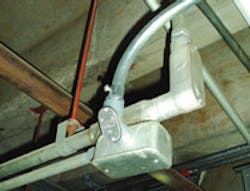As usual, never consider the following commentary associated with these photos as a formal interpretation of the National Electrical Code (NEC). Without criticizing anyone or any product, the following scenarios present us with serious safety questions.
All references are based on the 2005 NEC.
Flawed Extension. David Swyter, the owner of Swyter Electric in Reading, Mass., snapped this photo at a commercial customer's facility. Although he knows nothing about the initial installation, he thought this photo would bring an important Code violation to light.
The use of the handy box as an extension for any of the circuit conductors is not considered a recognized installation method in the electrical industry. Looks like the conduit body cover has a knockout or “hole” in it. This allowed the installer to pass wires through the connection and extend the circuit to wherever it may end. This is just another example of how the misinformed and unqualified do work in the moonlight!
Anchors Away David C. Hurd, facilities planning and construction manager for a school district and owner of Hy-Qual Construction in Chico, Calif., ran across this installation in the backyard of a residential property.
Hurd wondered if non-metallic conduit could be installed directly on top of a concrete walkway to provide power (50A) to a hot tub. Or more importantly, could any conduit be installed in this fashion? He noted that the conduit was not anchored in any way. Nothing is right here! The material should have been installed in accordance with the rules in Article 352, Rigid Nonmetallic Conduit, Part II, Installation. More specifically, 352.12(C) states that RNC shall not be used where subject to physical damage unless identified for such use. In addition, 352.12(D) notes that RNC shall not be used where subject to ambient temperatures in excess of 50°C (122°F), unless listed otherwise. Throw in the missing cover on the panelboard (not shown), messy and sloppy connections, and the missing cover on the GFCI device box, and you've quite a laundry list of violations on your hands.
Found a Code Violation? E-mail your photos to Joe Tedesco at [email protected].
About the Author
Joe Tedesco
Tedesco served the industry in many roles during his career. He was a director, senior electrical code instructor for National Technology Transfer, Inc. and American Trainco, Inc.. He was also a codes, standards and seminar specialist for the International Association of Electrical Inspectors and an electrical field service specialist for the National Fire Protection Association in Quincy, Mass. He ran his own business as an NEC consultant and is a Massachusetts licensed master electrician and journeyman electrician and certified electrical inspector (one and two family 2A; General 2B, and Plan Review, 2C). Tedesco also wrote articles for CEE News and EC&M (Code Violations Illustrated and What's Wrong Here?) for more than 15 years and helped launched the Moving Violations video series.
